Motorsports
One Lap of America Keeps Cannon Ball Baker’s Legacy Going Strong
Without Erwin George “Cannon Ball” Baker, it’s likely that nothing in the rest of this story would have ever happened. Baker, who passed away in 1960 at the age of 78, defied the odds by dying of a heart attack instead of crashing a motorcycle or a car while participating in one of the 130-odd […]

Without Erwin George “Cannon Ball” Baker, it’s likely that nothing in the rest of this story would have ever happened. Baker, who passed away in 1960 at the age of 78, defied the odds by dying of a heart attack instead of crashing a motorcycle or a car while participating in one of the 130-odd mad dashes he made from one side of America to the other, the first occurring in 1914 when he rode an Indian motorcycle coast-to-coast in 11 days. He backed that up a year later by driving a Stutz Bearcat cross-country, which also took 11 days.
Baker lived to set records, 143 of them, like the time he drove a Buick two-ton truck—loaded down with gallons of water from the Atlantic Ocean—to the Pacific Ocean in five days, 17 hours and 30 minutes. In 1933, he drove a Graham-Paige from New York City to Los Angeles in just over 53 hours, setting a record that stood for 31 years. The Indianapolis News once referred to him as, “Here-He-Comes-There-He-Goes Baker.”
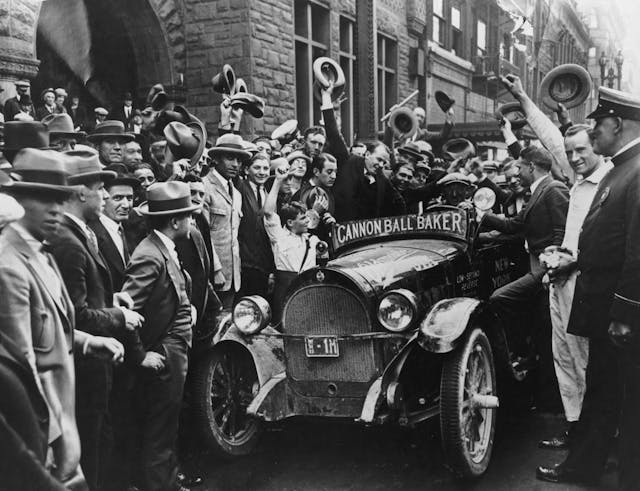
Sponsors loved Cannon Ball Baker, which is how he signed his name; he even copyrighted it, and Cannon Ball is what his tombstone reads at Crown Hill Cemetery in Indianapolis, lot 150, section 60. A 1929 Mobil Oil ad featured four men who were stellar examples of making possible “achievement through quality:” Pioneer aviators Charles Lindbergh and the Wright brothers, and Cannon Ball Baker. He was that famous.
No wonder Cannon Ball became a genuine folk hero to automotive journalist Brock Yates, who wrote 15 books but is perhaps best known for his work at Car and Driver magazine, a relationship that spanned 42 years. After Yates and a C&D editor named Steve Smith (not me—I’d figure into this story later) envisioned a Baker-style, modern-day cross-country dash, it was fittingly dubbed “The Cannonball Baker Sea-to-Shining-Sea Memorial Trophy Dash,” or just Cannonball for short.

Ostensibly, it was in protest of the national 55-mph speed limit, enacted to help save gasoline during the current gas crisis, which, no question, Yates hated. But part of his motivation, some suspect, was to just see what would happen.
Yates and his son, Brock Jr., age 14, along with Smith and family friend Jim Williams, made the first crossing alone, as a test, leaving from the now-famous Red Ball Garage in Manhattan on May 3, 1971, headed to the racer-friendly Portofino Inn in Redondo Beach, California, a distance of about 2900 miles, depending on your route. They were driving a much-modified 1971 Dodge Tradesman van, nicknamed Moon Trash II.
They made it in 40 hours, 51 minutes, considerably faster than any of Cannon Ball Baker’s runs, but the quartet in the Dodge van had something Cannon Ball never did: The interstate highway system.
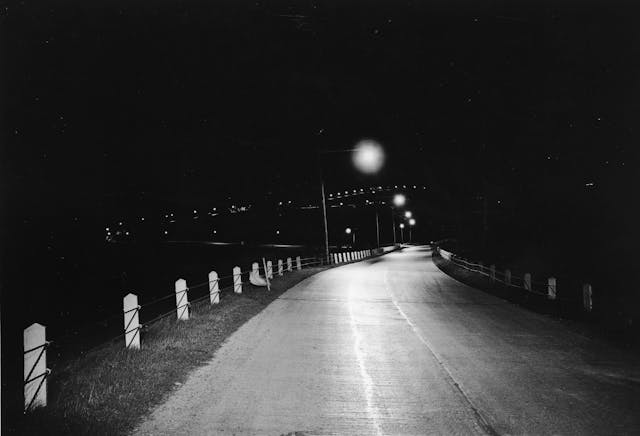
Satisfied by his sample, Yates and crew quietly laid out plans for an all-out assault on the federally mandated speed laws and the cross-country record, along with seven other teams that wanted in on the action. The first official, competitive Cannonball Run left the Red Ball Garage on November 15, 1971. The winning car rolled into the Portofino parking lot 35 hours and 41 minutes later: It was racing legend Dan Gurney, accompanied by Yates, driving a borrowed Ferrari Daytona. Tongue in cheek, Gurney said that at “no time did we exceed 175 mph.”
Yates said there would be another Cannonball Run, and there was: In fact, there were four in all. The second one was held November 13, 1972; the third on April 23, 1975, and the last one on April 1, 1979.
One of the Cannonball entries was Hal Needam, a top Hollywood stuntman who wanted to produce and direct movies, and he and Yates partnered to make multiple films that drew loosely on their experience with super-legal interstate travel at maximum speeds. First came Smokey and the Bandit (1977), quickly followed by Smokey and the Bandit II in 1980, both starring Burt Reynolds, who, at the time, was allowing Needham to stay in his guest house.
Then, in 1981, they finally made the first Cannonball Run movie. Needham directed it and Yates wrote it, but if you mentioned that to Brock, you’d get an earful about how he envisioned it as a more serious effort, starring auto racing enthusiast Steve McQueen, who was interested. But the Bullitt star was diagnosed with cancer and died at age 50 in 1980.
“Then Reynolds got hold of it, and turned it around completely,” Yates said. He was a little embarrassed about how the Cannonball Run movie turned into a slapstick farce, but he cashed the check. Made on a budget of $18 million, the film made $72 million in its first year, big money back then, and has since grossed $160 million. Film critic Roger Ebert gave Cannonball Run one-half of a star out of a possible four, and the less said about the two Cannonball sequels, the better.
Still, the movies made the Cannonball Run internationally famous, and interest from autocentric fans who wanted to compete in an actual Cannonball Run was at fever pitch. Yates knew the time had passed for the true Cannonball, so he conceived—and thanks for waiting for me to get around to this—One Lap of America, theoretically a more sedate event that had competitors driving around the U.S. from racetrack to racetrack, with timed stages in-between that could be accomplished, Yates promised, at a legal 55 mph.

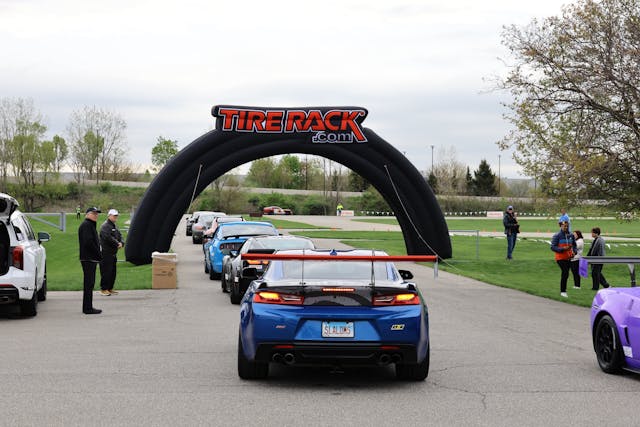

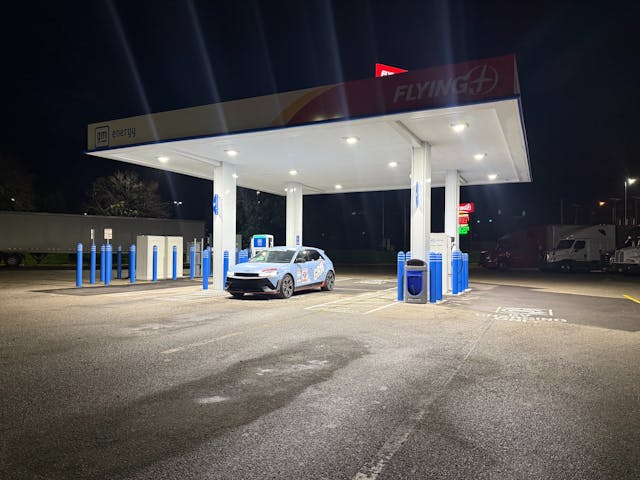
The first One Lap launched in 1984, an unorganized, fledgling effort that had competitors try to match exactly the mileage Yates himself laid down when he pre-drove the route. Not knowing exactly what roads Yates took, where he stopped for dinner, where he got lost, made it a guessing game. Some 76 teams were on the entry list in ’84, ranging from a Cadillac Cimarron, to a Porsche 930 Turbo, to an Itasca motor home, to a Hertz unlimited-mileage rental car, to a 1959 Rolls-Royce Silver Wraith.
Yates promised the 1985 event would be bigger, better, and at least more organized, as a time/speed/distance rally with point-to-point timed stages which you must complete no faster and no slower than your written instructions say: You’d be penalized one point for every second you were either early or late. These surprise timed stages were done en route to a variety of racetracks, where performance there would count toward the overall and class wins, too. Yates toured the country promoting the 1985 Uniroyal One Lap of America, visiting newspapers in the largest cities. That’s how I met Yates, and when I asked him if a seat might be available for the event, he said he’d see.
Not long after, Yates had added me to a team of several Chrysler factory entries. The bad news: I’d be on a three-man team driving a then-brand-new Dodge minivan. The good news: A fellow Chrysler teammate, driving a Chrysler LeBaron GTS, was Phil Hill, the 1961 Formula 1 champion, who also won the 24 Hours of Le Mans, the 12 Hours of Sebring, and the 24 Hours of Daytona. A kind, humble, extremely smart man, and one of my heroes; the day before we were to start the One Lap in downtown Detroit, Hill asked if I would drive him around to several stores. In my Dodge minivan. I’ve never made a more self-conscious trip.
My driving partners, whom I’d never met, were Ben Farnsworth, a commentator for the CBS Radio Network in New York City, and Bob Burns, a student who would go on to lead Land Rover and Range Rover’s off-road programs. Burns and I became lifelong friends; Farnsworth, not so much. You spend 10 sleep-deprived days hermetically sealed in a minivan with strangers, and you have no idea whether everybody will get along.
For 1985, the entries had swelled to a barely manageable 78, with a long list of alternates who wished they’d applied earlier. Notable was a 1985 Audi Quattro, with rally pros Ty Holmquist and Nicole Ouimet, and Car and Driver writer Jean Jennings, who was then Jean Lindamood.
Rocky Aoki, the founder of Benihana restaurants, was in a vintage Rolls that was equipped with a microwave, so he could prepare “the delicious new Benihana frozen meals” on the road. In a later One Lap, Rocky showed up in a Porsche 911 limousine.
Another Audi Quattro Turbo held rally champion John Buffum and experienced navigator Tom Grimshaw. Racer Anatoly Arutunoff, who can’t stand to miss anything and will be referenced later, was in a Mazda RX-7. Marshall Schuon, the New York Times automotive columnist, was in a Plymouth Voyager. Rally master Gene Henderson was in a turbocharged Subaru. Female race car drivers Patty Moise, Robin McCall, and Margie Smith-Haas shared a Chevrolet Suburban. And the bravest entry had to be brothers George and Timothy Fallar, in a 1984 Harley-Davidson TriHawk three-wheeler.
It was miserable and wonderful. Our route began in Detroit—a much-publicized launch that safety advocate Ralph Nader, a longtime nemesis of Yates, threatened to block by lining up wheelchair-bound individuals who had been seriously injured in car crashes, and Nader would tell everyone who listened that he essentially expected one of us to T-bone a school bus full of nuns. It’s important to report that no nuns were hurt during the running of any One Lap.
Neither Nader nor his wheelchaired constituents showed, and we were flagged off, one minute apart, by drag racer Shirley Muldowney. Who was, incidentally, in a wheelchair, recuperating from an accident in Montreal after she crashed into a wall at 245 mph. The car disintegrated, and Muldowney ended up in a field, still strapped in her seat, far from the initial crash impact. It was more than 18 months before she got back in her dragster.
The route took us to Michigan’s Upper Peninsula, then back south and west through Montana, where we were the last vehicle allowed through on a just-closed interstate, due to a blizzard. More than half the field didn’t beat the closure and were stuck for hours at a truck stop. It was no picnic on that road, either; I was driving at beyond-maximum speed, in a minivan, unable to see the pavement. I began hallucinating by the end of the storm. From there, west to Oregon, then south to the Portofino Inn in Redondo Beach, California.
That was the only stop on the schedule in the 9000-mile trip. The only night we’d spend in a bed was at the Portofino. The next morning, it was south and then east, through the Big Bend in far south Texas, to New Orleans and through Bourbon Street, then on to Jacksonville, Florida.
Somewhere between New Orleans and Jacksonville, we were able to stop at a cheap by-the-hour motel, which is about how long we were there—just enough time for three showers.
Then it was north for a midnight drive through Manhattan, to the Watkins Glen road course, then west through Ohio, where the One Lappers were greeted by at least a hundred state troopers, some of whom would follow our cars—at 55 mph, of course—all the way to the border. Then back north to the finish, at Detroit’s Renaissance Center. A bed awaited, but first there was the One Lap Official Banquet, at which more people snored than ate. The winner, to no one’s surprise, was the Buffum/Grimshaw Audi. We were stunned and delighted to have finished 17th. I drove in several One Laps after that one, but the 1985 grind was the most memorable, and generally considered the toughest of all.
Brock Yates died at age 82 on October 5, 2016. Well before that, the responsibility for One Lap fell to Brock Yates, Jr., part of that original one-van entry in May of 1971 that, along with his dad and two friends, made that original cross-country drive to test the Cannonball theory. Brock Jr. was, in fact, a bartender at the Portofino Inn, where I first met him 40 years ago.
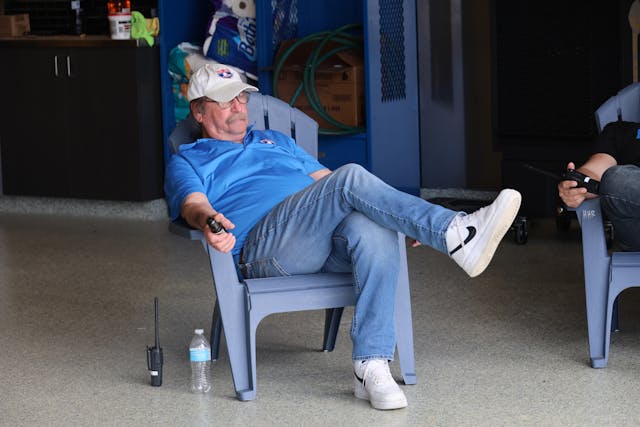
Now formally called the Tire Rack One Lap of America, the 2025 edition began at the massive Tire Rack headquarters in South Bend, Indiana, on May 3 and concluded at Tire Rack on May 10. In between, One Lap visited eight venues, including Gateway Motorsports Park just east of St. Louis; Virginia International Raceway; Pittsburgh International Race Complex; the little-known Hedge Hollow road course in southwest Missouri, and the NCM Motorsports Park in Bowling Green, Kentucky, owned by the National Corvette Museum and located next to the Corvette assembly plant.
Of the 41 One Laps, Brock Jr. has been on 38 of them, first as a competitor, and then running the show, starting with the 2009 One Lap. Over the years, One Lap has dialed it down from the one-night-in-a-motel frantic dash it was in 1985 to a targeted maximum distance of about 3500 miles done over eight days, with an opportunity to get some sleep every evening.

It’s a formula that works. This year, 83 cars were entered—85 is the maximum allowed—and the list included a bunch of Corvettes and Porsches, but also a 1963 American Motors Rambler Ambassador (there’s a Vintage class), and a 2017 Ford Focus (it competed in the Mid-Priced class). The entry fee per car is $4000, with lots of that going towards track rental—it’s much more expensive now than it used to be, Yates says—and administrative costs, including insurance. There’s also a charity aspect: Brock Sr. died after a 14-year battle with Alzheimer’s, and to date, One Lap has raised over $200,000 for the Alzheimer’s Association.
The experience level of the competitors varies dramatically—this year’s field included professional racers Randy Pobst and Ross Bentley—but the vast majority are amateurs. Brock Jr., a performance driving instructor himself, requires competitors to have completed at least two driving schools.
While many participants return year after year, there’s always a healthy batch of first-timers like Justin Schuh, 45, an experienced amateur racer from Loveland, Colorado, driving a 2019 Camaro ZL1 with the track-focused 1LE package, owned by his driving partner, Hsun Chen. The car is powered by a supercharged 6.2-liter V-8, pumping out 650 horsepower.

Or at least it was supposed to. Chen had only owned the car for six weeks, and it wasn’t fully sorted. On the racetracks, Schuh noted that the Camaro ZL1 did fine on the corners, but it was slow on the straights. There was another Camaro ZL1 in the field, “and the driver of that car mentioned that he’d hit 161 mph on the straight at VIR, and we thought, ‘That’s 20 mph faster than us. Something is wrong with our car.’”
While Schuh drove to the next track, Chen began Googling all the potential problems. One likely culprit: The air-to-water intercooler. Indeed, “Half of the intercooler coolant had bled out of it through its six-year life of basically doing nothing, and we had about half the horsepower we should have had up until the last three events,” Schuh says. They discovered that it wasn’t a big deal: “Top it off and burp it, using a screwdriver, a funnel, bottled water, and duct tape. Near Beaver Run. Or Pittsburgh. Someplace. And suddenly we had the top speed that we were supposed to have had all week long. The car was transformed.” The closing event was the wet skid pad at Tire Rack, and Schuh won it.

So what drew him to One Lap? “It had always been on my bucket list,” Schuh says. “I looked at the route, and I’d been to a couple of the tracks, and I asked my wife if it was OK for me to disappear for nine days. Maybe 10. And she said, ‘You’ve talked about this before—you’d be silly not to do it.’ So I did.”
But would he do it again? As is common with One Lap participants, right after the event was over, Schuh thought, “Never again. Not for me. It’s a pretty brutal event as far as sleep goes. But as I began talking to some friends, telling stories about it and all the good times we had—with the right car and the right co-driver, I think I’d do it again. You have stories to tell for a lifetime. It was a week-long race, whether the stopwatch is on you or not. It was fun. It really was.”
The event is unique, he says, as “You’d better be able to switch both you and the car from transit mode to track mode. I don’t think there’s a better test of street cars out there. You can spend all the money you want for something super racy, but you’d better be prepared to live with it for a week.”
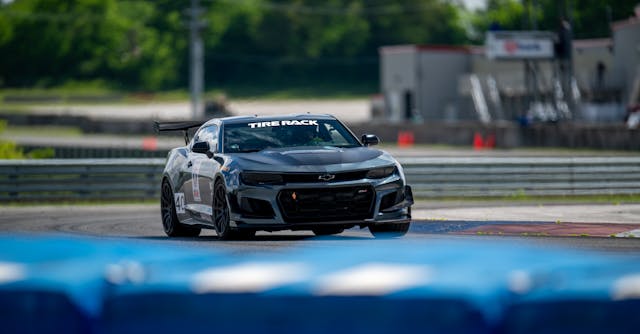
Another factor is that competitors are presented with a list of 200-treadwear tires available from Tire Rack: This year, there were 13 brands. Teams choose the tires they want, and you must run those four tires for the entire event. Schuh and Chen picked Continentals, which Schuh said are great in the rain, because past One Laps tended to be wet. This year was surprisingly dry, but the Continentals did their job on that wet skid pad event that Schuh won.

For Tom Suddard, the publisher of Grassroots Racing and Classic Motorsports magazines in Holly Hill, Florida, this was his fourth One Lap. While Grassroots is a presenting sponsor, Suddard uses the event to thoroughly test a car, and this year, it was a 2025 Hyundai Ioniq 5 N, entered in the Alternative Fuel class, with that fuel being, of course, electricity. The 5 N is the performance version of the Ioniq, and is capable of up to 641 horsepower.
But isn’t he taking a chance, with so much time spent hurrying from point to point, that they wouldn’t be able to find a charger when they needed one? No, Suddard says; he’s done this before, and “This is the first time, honestly, where every charger worked—we didn’t have any issues, didn’t have to go out of our way—and it really didn’t slow us down. We were getting to the hotels about the same time as the gas cars.”
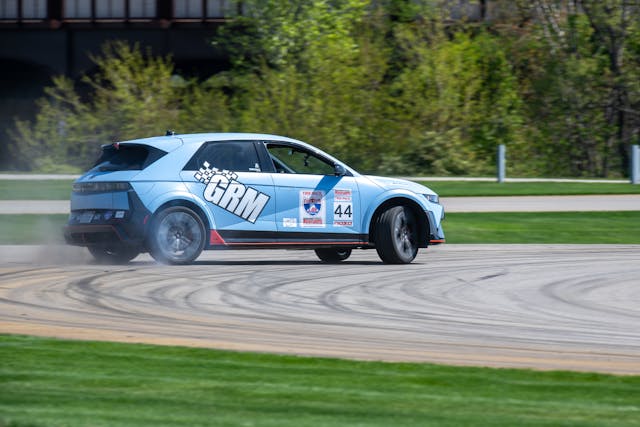
Performance, he says, was “Pretty stunning. It’s still a 5000-pound SUV, and the laws of physics still apply, but it was super durable. We could run it as hard as we wanted on track without worrying about the charge. It didn’t slow down as the battery reserve was used up; in fact, we ran one of our best laps at VIR with the car at the lowest charge level of the whole trip.”
Suddard keeps coming back, he says, “Because I really enjoy the challenge. I love the challenge of learning a course that nobody’s ever seen before, having to do it quickly, then having to race on it right away. That’s what really draws me to it, and the fact that it’s a week long, and so many transit miles, the physical and mental aspect of performing not just one day, but for a week straight.”
And then there’s the people. “You see some of the same people over and over again, every time, and it’s like a big family that comes together for the event. People you haven’t talked to in a year, you’re right back at the dinner table with them, telling stories, having a blast.”

This is a good place to mention the overall winners of the 2025 Tire Rack One Lap of America Presented by Grassroots Motorsports: It was team number 2, Salil Shukla and Christopher Mayfield, driving a white 2024 Porsche Cayman. Certainly not the most powerful entry in the field, but obviously a versatile and well-driven car. Worth noting is that an electric car, a 2021 Tesla Model S, finished second overall.
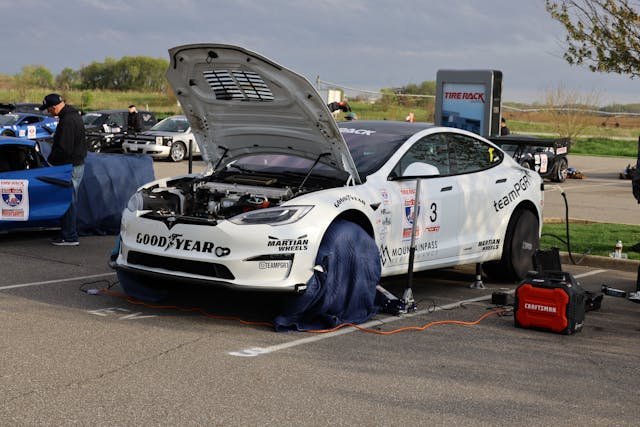
The car count, vehicular variety, and camaraderie are music to the ears of Brock Yates, Jr. He’s already working on the route for the 2026 edition of One Lap of America—it’s different every year. For the event itself: “Basically, I’m the nanny,” Yates says. Herding 83 cars from place to place, making sure they all get the track time they were promised, supervising the track workers, who are typically different from one track to the next; yeah, it’s work. “But I’m still having fun,” he says.

Yates says one of the hardest parts of the job is booking racetrack time. Not that long ago, “Racetracks were sallow for most of the year,” he says, and they were eager to book One Lap. Now, most of the good ones are busy—“If I don’t get all my requests for track time in by August for the next year, I’m out of luck.” Part of that, he believes, is due to One Lap’s tradition of introducing new drivers to racetracks, driving their street cars—track days, they call it now.
Arguably, he says, it began in 1989, when One Lap descended on the Hallett Motor Racing Circuit in Oklahoma. Then, the Sports Car Club of America sanctioned One Lap, and their rules were a little too restrictive for Brock Sr., and Hallett’s owner, the aforementioned racer and One Lap veteran Anatoly Arutunoff, so rather than run a slalom course on the front straight, they basically turned the cars loose on the track, one at a time like always, and you could go as fast as you were able. “We learned that street cars could actually run on racetracks and not spontaneously combust. Out of that came TrackTime, Car Guys, and a bunch of other racing schools. After we ran Hallett, it opened up a whole new industry,” Yates says.

Every year, Yates says, the quality of cars entered increases, but he worries about the amount of horsepower presently available to inexperienced drivers. Those cars often have manual transmissions, but few of the new drivers, he says, can heel-and-toe, which is where the driver brakes with their right toes while flipping the throttle with their right heel, enabling the engine’s rpms to match the lower gear on the downshift. Yates Jr., as a kid, used to marvel at his father’s ability to heel-and-toe, “and I taught myself to do it by practicing for hours on a Morris Minor that didn’t run. I was learning smoothness, and gentle downshifts.”
Now, he says, “People show up at racetracks with, say, a Mustang Shelby GT350 and tell me, ‘Teach me how to drive this stupid thing.’ Without a clue, without a background, without reading any books on driving. That’s what I’m contending with. We’ve always had the two-driving-schools minimum, but most of them can’t heel-and-toe—they’d rather use those little paddley things behind the steering wheel. They’re not prepared when they overstep the machine’s limits.”
“I’m not touting the fact that I’m a great driver, because I’m certainly not. Middling, at best. But I’ve been able to save myself and get out of some really stupid situations.” With so many new performance cars, Yates says, “You are removed from the driver’s seat. You are insulated. Desensitized.” Sometimes when Junior talks, I hear Brock Senior.
“I worry for the sport, I guess. I’m an old fart, and I admit it. But there’s a lot to be said for old school. For analog. That’s my rant for the week.”
If worrying keeps Junior motivated to run successful One Laps year after year, we’re all for it—bringing out the Pobsts and the Bentleys of the racing world and attracting weekend hotshoes like Schuh will help keep motorsports—and Cannon Ball Baker’s legacy—alive. Farts of any age with interest in the 2026 One Lap of America are welcome to keep an eye on the official website, and Facebook, for information about the 42nd One Lap of America. If you’d like to compete, sign up early: There’s typically a long waiting list.
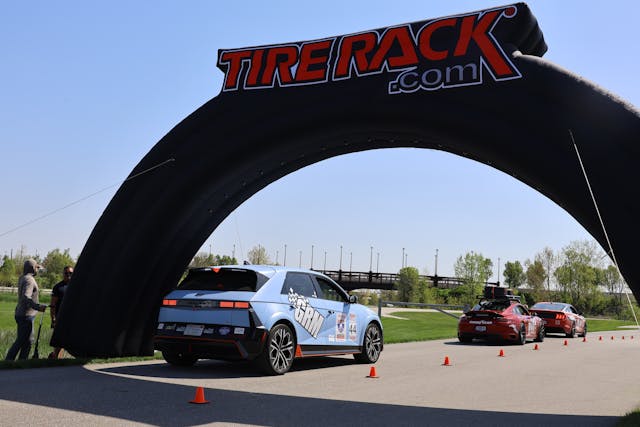
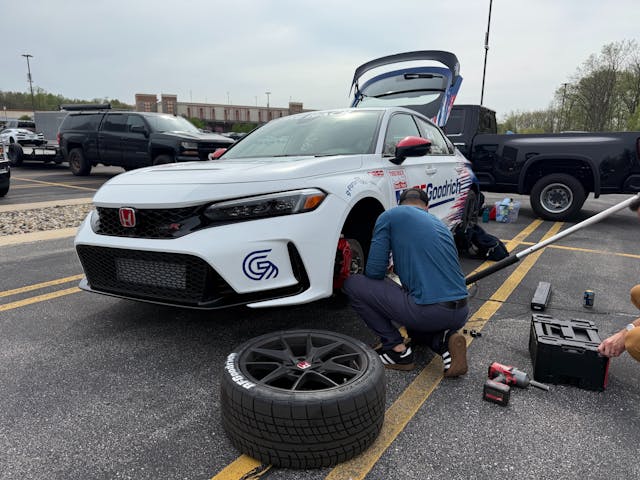
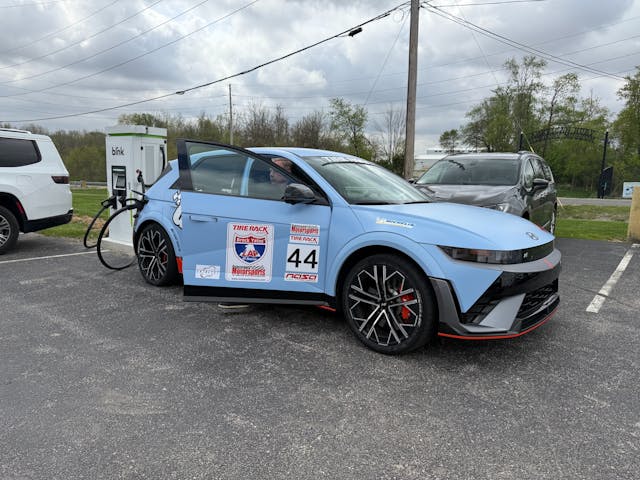


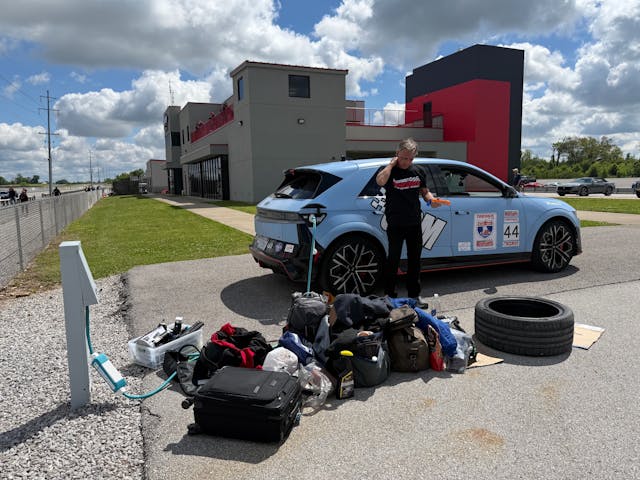








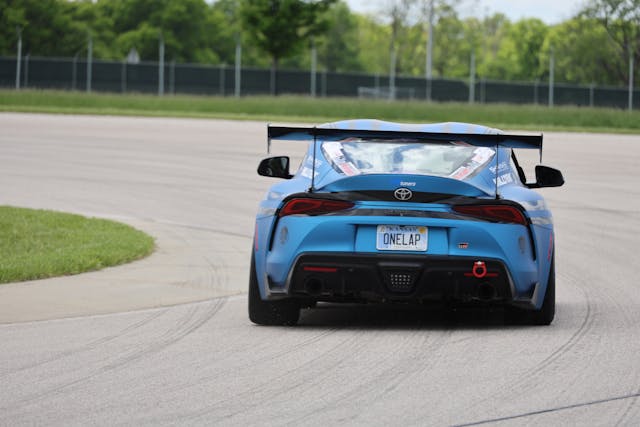
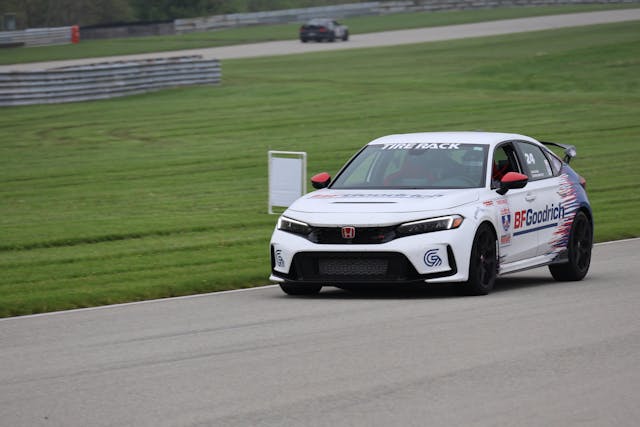


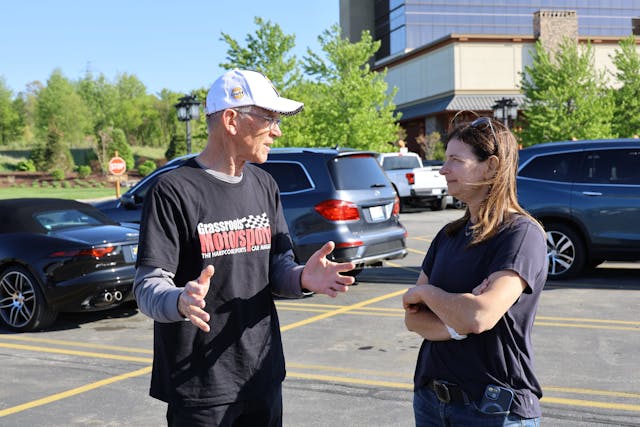
Motorsports
NASCAR Insiders react to Ty Gibbs furious reaction after Denny Hamlin win at Michigan
Two NASCAR insiders understood why Ty Gibbs was frustrated after Denny Hamlin won the Cup Series race at Michigan on Sunday. On The Teardown podcast, Jeff Gluck and Jordan Bianchi of The Athletic reacted to Gibbs being not happy after earning a third-place finish. “I do get his frustration. I think from his standpoint, he’s […]

Two NASCAR insiders understood why Ty Gibbs was frustrated after Denny Hamlin won the Cup Series race at Michigan on Sunday. On The Teardown podcast, Jeff Gluck and Jordan Bianchi of The Athletic reacted to Gibbs being not happy after earning a third-place finish.
“I do get his frustration. I think from his standpoint, he’s now 24th in points,” Gluck said about Gibbs, who was told to save fuel at the end of the race instead of going for the win. “He’s probably thinking ‘We should be almost the same sort of mentality that [William] Byron had to just, hey, I don’t care if I run out of gas. This is my season.’”
Bianchi agreed with Gluck as he also understood why Gibbs was frustrated at the end of the race. “Even though Ty doesn’t have wins in the bank, you’ve got to look at it as we need to be aggressive here. We need to put ourselves in position to go for the win because that is how we’re going to get in the playoffs. I get his frustration. I get it, especially when the same guy who wins the race is on the same fuel strategy with you and I believe he let Denny go by him.
Ty Gibbs speaks out on ‘unfortunate’ finish at Michigan
“…Yeah, you’re frustrated and it’s been that kind of year for Ty. I also see the team side of it, too of like, ‘Hey, this is part of it. This is big pictures thing.’ They’re both right to some degree, but I understand Ty’s frustration, and I would be frustrated in that moment too. Finishing third in the grand scheme of things doesn’t do anything for you.”
In 94 Cup Series races, Ty Gibbs has earned 25 top-10 finishes but has yet to win a race. While Gibbs might be happy that his Joe Gibbs Racing teammate got the win, he believes that he could have earned his first victory in the Cup Series and clinched a playoff spot.
“Yeah, it’s just unfortunate because I feel like we had the capability to go do it,” Gibbs said after the race, per NASCAR.com. “I feel like we showed we were fast enough to go do it. It’s definitely frustrating, but it’s just part of it sometimes.”
Motorsports
NASCAR finds big-name replacement after losing $2M sponsor – Motorsport – Sports
After losing McDonald’s as a partner sponsor for the upcoming 2025 Chicago Street Race (the Grant Park 165), NASCAR has pivoted to another fast-food sponsor: Arby’s. The terms are unconfirmed, but it’s thought Arby’s will substitute the $2 million McDonald’s paid. The deal will include on-site activation space and a NASCAR-themed sweepstakes across 47 locations […]

After losing McDonald’s as a partner sponsor for the upcoming 2025 Chicago Street Race (the Grant Park 165), NASCAR has pivoted to another fast-food sponsor: Arby’s.
The terms are unconfirmed, but it’s thought Arby’s will substitute the $2 million McDonald’s paid. The deal will include on-site activation space and a NASCAR-themed sweepstakes across 47 locations in the Chicago region.
During the race, Arby’s will be represented by Rick Ware Racing’s Cody Ware in the No. 51 Ford Mustang. McDonald’s still represents drivers Tyler Reddick and Bubba Wallace, though the charter status for both drivers is still up in the air after 23XI Racing was dealt a legal setback.
NASCAR Senior Vice President and Chief Commercial Officer Craig Stummel touted the agreement in a recent press release. “It’s a watershed moment anytime you have a new brand joining the sport for the first time, especially when it’s a partner like Arby’s with such a unique, recognizable brand,” he said.
“The fact that we’re welcoming Arby’s to NASCAR on the streets of Chicago speaks to the tremendous momentum behind the NASCAR Chicago Street Race and the sport overall.”
Subscribe to our NASCAR newsletter
Arby’s was founded in 1965 and boasts over 3,000 locations nationwide. They’ve attracted wide-scale recognition thanks to a series of national ad campaigns.
“Arby’s is thrilled to hit the track as a Founding Partner of the 2025 NASCAR Chicago Street Race,” said Arby’s Chief Martking Office Jeff Baker.
“This marks an exciting moment for our brand in the world of motorsports, with one of the most dynamic and groundbreaking events in racing. Nothing goes better with NASCAR than one of our delicious Arby’s sandwiches, and we can’t wait to bring the meats to the streets for race fans and Arby’s fans in Chicago and beyond.”
The city of Chicago agreed to a pact with NASCAR ahead of the 2023 Cup Series season to host three street races. Shane van Gisgbergen turned heads by winning in 2023 on his Cup Series debut. Alex Bowman captured the checkered flag at last year’s Grant Park 165.
DON’T MISS:
ABB, Blue Cross, and Xfinity are other founding partners for the race set for July 6. It is the 18th race of the 2025 Cup Series season.
Motorsports
Longtime NASCAR Announcer Rick Allen Set To Join CARS Tour Broadcast
It’s been a while since race fans have heard the voice of Rick Allen. After calling NASCAR Cup Series races on NBC Sports from 2015 until 2024, and before that the NASCAR Craftsman Truck Series for many years, Allen was left on the sidelines entering the 2025 TV deals for NASCAR. But on Saturday night, […]
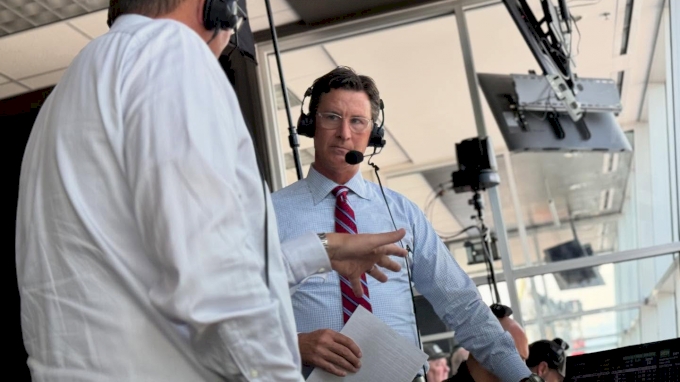
It’s been a while since race fans have heard the voice of Rick Allen. After calling NASCAR Cup Series races on NBC Sports from 2015 until 2024, and before that the NASCAR Craftsman Truck Series for many years, Allen was left on the sidelines entering the 2025 TV deals for NASCAR. But on Saturday night, fans of the CARS Tour will hear Allen’s voice alongside Blake McCandless on the FloRacing broadcast of the “Mini’s Mission 125” from Dominion Raceway.
2025 CARS Tour at Dominion Raceway
Allen’s participation came about initially as a bit of a joke between friends when Allen made an appearance on Dale Earnhardt Jr.’’s “Dale Jr. Download” podcast back in May. While at the time they were joking together, a hole opened up for the June 14 race from Dominion as regular announcer Eric Brennan would not be able to make that event.
“(Dale) had me on and we talked about what I was doing and what I wanted to do, and I think jokingly he said, ‘I’ve got two CARS Tour races I need an announcer for,” explained Allen to FloRacing. “So I raised my hand and said I’m available. He thought I was joking, but I said I’m not joking, I’d do it for him as a favor.
“A week after the podcast he reached out to me and said, ‘Are you serious about potentially doing one of the CARS Tour races or both of them?’ I told him I’d love to look at it and see if my schedule would allow it. I said, ‘Let me do the June 14th race at Dominion and we’ll go from there.’ So for the immediate future we’re doing this one and we’ll see how it goes.”
Allen said the main goal for this week is to have fun and watch racing and talk about racing, which is something that he has not been able to do on-air since the end of the 2024 season. And even though Saturday’s race is a Late Model Stock Car race on a pavement short track, it’s allowing him to get back to his roots a little bit. Allen got his start calling races at the dirt track of Eagle Raceway in his home state of Nebraska.
“I cut my teeth on a little short dirt track in Nebraska. I love that racing. I love that atmosphere. I had a great time doing it when I started calling races,” Allen said. “So just to get back there and have some fun and watch a little racing and see if I can add a little bit to this broadcast. And to enjoy myself and take the weekend for what it is, which is me being able to watch a race and have a little fun on the broadcast side.”
One thing that Allen is going to have to learn, and quickly, is who is driving which car. In CARS Tour competition, duplicate car numbers are allowed, which is very different from the upper levels of NASCAR where there can only be one car per car number. In the CARS Tour, it’s not strange to see multiple cars with the number 88, for example. The diehards of the Tour know that Connor Hall is in the 88, while Doug Barnes Jr. is the 88B. But for Allen, it’s the little things like that that will take some learning while he hammers through his prep work for the weekend.
“I was going through the entry list and one of my first questions for our production meeting this afternoon is, ‘Are you guys messing with me?’ Because, there are four number four cars entered in this race. What’s that all about?” Allen asked with a laugh. “I think these guys are playing a trick on me, so we’ll have to figure that out.
“But I’m definitely studying. I always like to be very prepared. I want to know as much as possible about anybody and everybody that could be part of the broadcast,” said Allen. “That means crew members, drivers, family members. I want to know as much as I can about that. That’s kind of where my studying is. The racing really presents itself, so that’s just calling the action on the track. But I like to add to the broadcast by telling people a little more about the people they are watching. Whether it’s a sporting event or a show, whatever it is, I like to learn.”
One of the added elements to this particular weekend is the meaning behind the event. “Mini’s Mission” is the foundation started by full-time CARS Tour competitor Mini Tyrrell after Tyrrell learned about his childhood friend being diagnosed with cancer. This entire weekend is meant to place a spotlight on children who are battling pediatric cancer and their families who are there alongside them every step of the way.
For Allen, that means not just learning who the drivers are and which car they drive and their stats, but also about each child and their family that is being matched with every driver in the field, as well as their stories.
Allen explained that he’s been part of a similar foundation with a similar cause for the better part of the last decade. Allen said that a young man named Jack Hoffman from Nebraska was diagnosed with brain cancer, and Allen has been with his foundation because of how much his story touched him.
“I’ve always had a soft spot in my heart for these kids that are just handed this disease, and how valiantly they fight it,” Allen said. “When I was reading about Mini’s Mission, it really touched my heart that I’ve been put into this broadcast for a reason. There’s a reason I’m here, and there’s a reason it was this one and it was Mini’s Mission that is the title of the race.
“Kids fighting this disease is something that I want to give 100-percent attention to, and that’s hopefully the way I’m going to start this broadcast out. I know as racers and as fans of racing, we tune in to watch a race. But I hope that we’re going to educate and let people know and give them a reason to look up the cause and be sympathetic to these kids that are fighting a fight that they didn’t sign up for. They’re fighting very valiantly, and their families are right there with them.”
The “Mini’s Mission 125” broadcast from Virginia’s Dominion Raceway will begin at 4:15 p.m. ET with qualifying. The 125-lap main event is expected to see the green flag fly at 7 pm. ET.
Fans can watch Saturday’s race and listen to Rick Allen live on FloRacing with a FloRacing subscription. Fans can join FloRacing by clicking here.
Motorsports
Marcus Armstrong Ignites Indy 500 Buzz with Spectacular Spectrum Sponsorship Deal
A groundbreaking partnership has been forged in the world of motorsports as Spectrum cable extends its deal with Meyer Shank Racing. The acclaimed racing team announced Spectrum cable as the new primary sponsor for the upcoming Indianapolis 500, adorning the No. 66 Honda driven by the talented Marcus Armstrong. But that’s not all – the […]
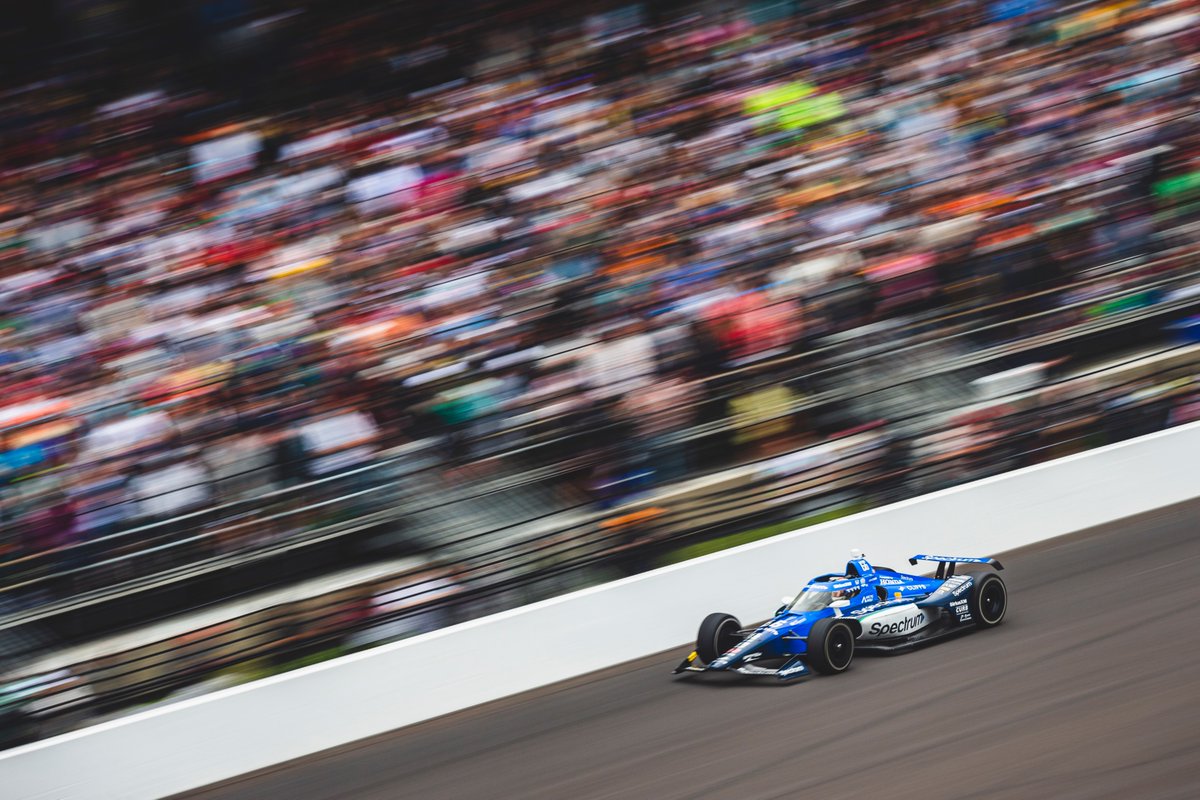
A groundbreaking partnership has been forged in the world of motorsports as Spectrum cable extends its deal with Meyer Shank Racing. The acclaimed racing team announced Spectrum cable as the new primary sponsor for the upcoming Indianapolis 500, adorning the No. 66 Honda driven by the talented Marcus Armstrong. But that’s not all – the broadband provider has committed to sponsoring four additional races, solidifying their support for the team and the sport.
The collaboration between Spectrum cable and Meyer Shank Racing signifies a significant milestone in the racing world, with both entities poised to dominate the track and the airwaves. The sleek design of the No. 66 Honda, now emblazoned with Spectrum’s branding, is set to turn heads and capture the attention of racing enthusiasts around the globe.
Fans and industry insiders alike are buzzing with excitement over this dynamic partnership, eagerly anticipating the thrilling races that lie ahead. With Spectrum cable’s unwavering support, Meyer Shank Racing is gearing up for a season of adrenaline-pumping action and fierce competition.
Stay tuned as the countdown to the Indianapolis 500 begins, with the No. 66 Honda and Marcus Armstrong poised to make a statement on the track with Spectrum cable riding along as the ultimate partner in speed and technology.
Motorsports
Happinessa achieves season’s-best result, secures Lady Trophy victories
Happinessa secured Lady Trophy victories as she overcame challenging conditions in the NASCAR Euro Series at Brands Hatch, where the Bremotion driver bounced back from a high-speed crash in the previous round at Vallelunga to secure her first top-15 finish of the season. Photo credits: Bart Deahese / EuroNASCAR Happinessa secured Lady Trophy victories as […]
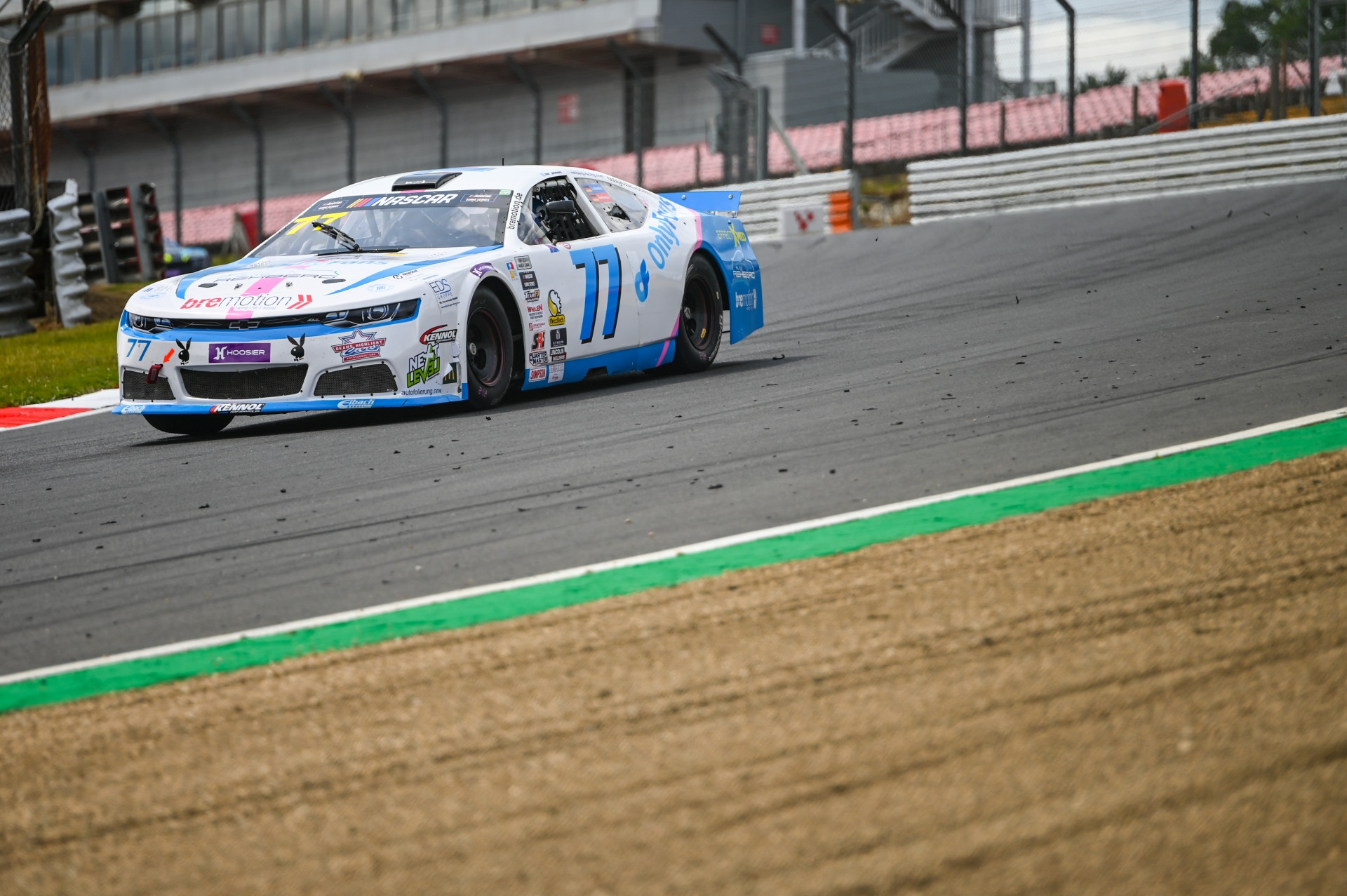
Happinessa secured Lady Trophy victories as she overcame challenging conditions in the NASCAR Euro Series at Brands Hatch, where the Bremotion driver bounced back from a high-speed crash in the previous round at Vallelunga to secure her first top-15 finish of the season.
Happinessa secured Lady Trophy victories as she overcame challenging conditions in the NASCAR Euro Series at Brands Hatch. The Bremotion driver bounced back from a high-speed crash in the previous round at Vallelunga to secure her first top-15 finish of the season.
Happinessa also experienced her first competitive wet weather running in race one as the German driver continues to progress in her debut season of racing.
Following a period of recovery and recuperation after a significant incident at Vallelunga, Happinessa returned to the NASCAR Euro Series at Brands Hatch. The German driver demonstrated great determination to come back to competitive action less than one month after this incident with the Bremotion team working hard to prepare her car. Despite being the shortest circuit on the NASCAR Euro Series schedule, the iconic Brands Hatch circuit was a challenging one to master with Happinessa keen to battle within the competitive midfield.
On-track action began on Friday with two free practice sessions for the drivers to familiarise themselves with the Brands Hatch Indy layout. Happinessa completed 14 laps in session one and set a quickest time of a 52.225 which placed her 17th overall. In session two, the German racer battled technical issues with the Bremotion team working hard to rectify these ahead of Saturday’s action.
Following overnight rain at Brands Hatch, the track was damp away from the racing line for Saturday morning’s qualifying session. Happinessa was caught out by these tricky conditions early in the session as she spun into the gravel trap at Paddock Hill bend. The Bremotion driver therefore ended qualifying in 21st position and was looking ahead to the two races which followed.
Race one of the weekend took place on Saturday afternoon with Happinessa lining up from 21st on the grid. The track was initially dry, before light rain started to fall as the drivers fired their engines. As the pace laps commenced, the rain intensified and a number of drivers headed for the pits to change onto the wet tyres.
Happinessa remained on the circuit and as a result, she was running in a career-high position of fifth prior to the green flag being displayed. Track conditions remained extremely wet as the race got underway and a number of cars began aquaplaning off the circuit. As a result, the race was red flagged after one lap with Happinessa doing a superb job to remain on track as she ran in ninth position.
Following a short delay while the rain eased, the cars returned to the circuit behind the safety car with Happinessa taking up her ninth position. The Bremotion driver then pitted prior to the green flag being displayed due to an issue with her wipers which made it unsafe for her to continue as the rain persisted at Brands Hatch.
Conditions remained extremely challenging throughout the race and Happinessa was able to rejoin the circuit with six laps remaining to gain valuable wet weather experience. Although she was unable to achieve the finish she had hoped due to the extended stay in the pits, Happinessa claimed the Lady Trophy victory.
For the second race of the weekend on Sunday afternoon, conditions had improved at Brands Hatch and the track was fully dry. Happinessa lined up from 22nd position on the grid and was immediately promoted to 19th with three drivers failing to take the start. As the green was flag was displayed, the Bremotion driver made an excellent getaway and gained four on-track positions to end lap one inside the top-15.
Happinessa was doing well in the initial stages to defend from Michael Bleekemolen, however the veteran racer moved ahead on lap three. A recovering Thomas Toffel also overtook the Bremotion driver on lap four, before Happinessa came under attack from Sven Van Laere. The German racer did a good job to defend her position, while also setting her fastest time of the entire event on lap five.
On laps seven and eight, technical issues for both Toffel and Claudio Remigio Cappelli elevated Happinessa back into the top-15 as she targeted her best overall finish to date. With both cars requiring retrieval on the exit of Druids, the race first entered a full course yellow period before the safety car was deployed.
The race resumed on lap 14 and after again defending well from Van Laere, the Belgian driver moved ahead on lap 16 with Mike Wise following him through. Happinessa was quick to reclaim the position from Wise, while a retirement for Bleekemolen saw the Bremotion racer enter the top-15 once again. As the race entered the closing stages, Happinessa did a nice job to manage faster traffic moving ahead as the leaders put the German driver one lap down.
Happinessa remained ahead of Wise and extended her margin to the American debutant with just two laps remaining. Fluid was then spilt on the track entering Paddock Hill bend and this led to a number of drivers leaving the track and hitting the barriers.
Fortunately, Happinessa remained on the circuit and the race was subsequently red flagged due to the slippery track conditions. Therefore, Happinessa was credited with her best result of the season in 15th, while also claiming the Lady Trophy for the second straight race.
Happinessa overcame adversity during the weekend to score her best result in the NASCAR Euro Series. The Bremotion driver showed good improvements as she tackled changeable track conditions at Brands Hatch. She will now be looking to build upon this progress when the championship returns to Autodrom Most in Czechia, following an extended summer break, on the weekend of August 30th/31st.
Motorsports
What Does a Weekend at Michigan International Speedway Look Like?
Watching NASCAR races on TV is one way to spend a race weekend. However, if you’re lucky enough to attend an actual race, the experience is always better. That’s exactly what this past weekend was like for me. I spent the weekend at my home track, Michigan International Speedway. It wasn’t my first time, since […]

Watching NASCAR races on TV is one way to spend a race weekend. However, if you’re lucky enough to attend an actual race, the experience is always better. That’s exactly what this past weekend was like for me. I spent the weekend at my home track, Michigan International Speedway. It wasn’t my first time, since I’ve been going to races since I was a little boy. MIS never disappoints. Hence why I like going every year.
What does a weekend at Michigan International Speedway look like?

There is racing action from Friday until Sunday, when NASCAR visits the Irish Hills. A little advice: Sure, the ARCA Menards Series raced on Friday, but that is also the best day to get your merchandising shopping done. I am a big die-cast collector myself. So when I made my way to the Chase Elliott hauler looking for his Amazon Prime 1/64 die-cast, I was very lucky. I got the last one, as the workers at the hauler had to pull the car from their display case. Sometimes you can’t be as fortunate.
Elsewhere, Friday was a good day to get an idea of where your favorite driver could be appearing. Hendrick Motorsports’ Chase Elliott and Kyle Larson would both be signing at their haulers on Sunday. Only 100 wristbands were being given on Friday, plus fans had to purchase a 1/24 die-cast to receive the wristband. I won’t lie, I was one of those people as I got a wristband to get Larson’s autograph.
Another great thing about MIS was seeing all the sponsors with their activation booths. That included a huge RAM Trucks display. Which I’ll get back to more on, given all the rumors that were floating around over the past weekend.
That Truck Wreck on Saturday Was Wild
The best part of going to a NASCAR race is that you never know what could happen. I like taking my dad to the races, and we both had a great time. The Craftsman Truck Series on Saturday didn’t disappoint. From great racing on track for the first time in the series in five years. To maybe one of the craziest moments seen in years.
The truck racers had a big moment with under 10 laps to go on a restart, as none of them got going, leading to a massive wreck. The best part of that incident was that it happened right in front of where I was seated in the grandstands. I’ve seen some wild things in my 28-plus years in NASCAR, but to see that in person was insane.
If that wasn’t enough to see such a great crowd for the Truck Series was simply special. I don’t have a total number, but boy, was everyone around me having a great time. Especially the rowdy group that was throwing Jello-shots at everyone else in the crowd. I suppose that’s just how NASCAR fans do it at Michigan. There is nothing wrong with that.
Cup Race Didn’t Disappoint
Sunday was a great day all around. Sure, plenty of people weren’t happy with Denny Hamlin crossing the line first, but that didn’t ruin my weekend. I got to see hard racing and plenty of drama around the race track.
I spent the morning listening to plenty of the drivers speak at their Q&A sessions. That was before I had to go jump in line to get Kyle Larson’s autograph. While I was doing that, my sister lucked out, as she was at the race with me. She got to get her favorite driver’s autograph on her hat. She got it signed by Elliott at the Chevy display.
It’s great to see all these drivers making appearances, and especially for the fans to interact with their favorite driver. It’s the biggest opportunity I’ve seen for people to get a chance to get something signed by the drivers at MIS in several years. While all that was going on, the biggest reason why I knew the RAM Display was so important was that the NASCAR Craftsman Truck Series had a huge announcement at 1 pm on Sunday before the Cup race.
It’s not a secret anymore. Dodge RAM is returning to the Truck Series. I knew it was true the minute I saw the display on Friday. So welcome back, Dodge. As for the racing action on Sunday. From my seat at the end of pit road heading into turn one, I got to see all of the action. From Alex Bowman’s massive head-on crash into the outside wall off of turn two, to Denny Hamlin outdueling William Byron before he ran out of fuel.
Read More: RAM Trucks returning to the NASCAR Craftsman Truck Series in 2026
Not to mention the pair of Larson fans who were making the rounds on Social Media for cheering him on every lap. Those guys were about four rows below me to the right.
Just some good ol boys cheering on Kyle Larson. They’ve been doing this all race for every car Larson passes. Needless to say they’ve done it a lot
love their energy!! #Nascar #KyleLarson pic.twitter.com/m11Oq93kcV
— ACS Racing Network (@ACS_onYouTube24) June 8, 2025
It was yet another great NASCAR weekend at Michigan International Speedway. I’m glad to have been there, and will continue to go to my hometown for as long as possible. There’s nothing like living just about 45 minutes away from a NASCAR track.
Read Next: Chevy Flexes Power, But Denny Hamlin Stands Tall in Irish Hills
Main Photo: Meg Oliphant, Getty Images
Recording Date: 6/8/2025
-

 NIL2 weeks ago
NIL2 weeks ago2025 NCAA Softball Tournament Bracket: Women’s College World Series bracket, schedule set
-

 Health6 days ago
Health6 days agoOregon track star wages legal battle against trans athlete policy after medal ceremony protest
-

 Professional Sports7 days ago
Professional Sports7 days ago'I asked Anderson privately'… UFC legend retells secret sparring session between Jon Jones …
-

 College Sports2 weeks ago
College Sports2 weeks agoIU basketball recruiting
-

 Professional Sports7 days ago
Professional Sports7 days agoUFC 316 star storms out of Media Day when asked about bitter feud with Rampage Jackson
-

 Rec Sports2 weeks ago
Rec Sports2 weeks agoScott Barker named to lead CCS basketball • SSentinel.com
-

 Youtube3 weeks ago
Youtube3 weeks agoAnt greets A-Rod & Barry Bonds before Game 3
-

 Rec Sports2 weeks ago
Rec Sports2 weeks agoJ.W. Craft: Investing in Community Through Sports
-

 College Sports2 weeks ago
College Sports2 weeks agoOlympic gymnastics champion Mary Lou Retton facing DUI charge
-

 Motorsports2 weeks ago
Motorsports2 weeks agoNASCAR Penalty Report: Charlotte Motor Speedway (May 2025)


































